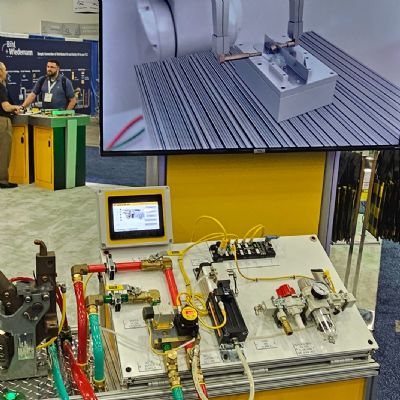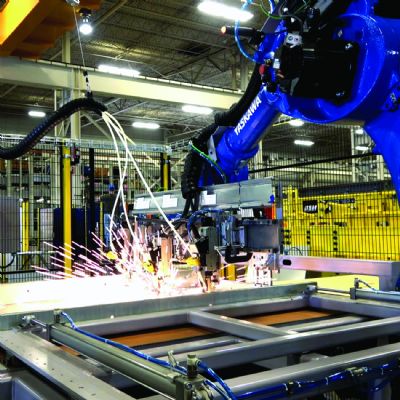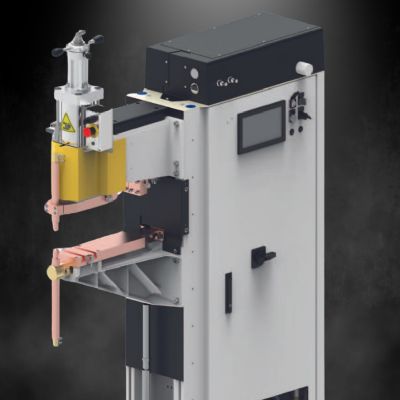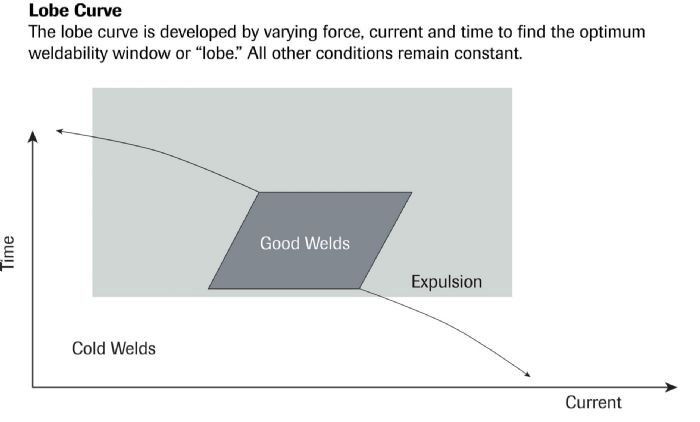 Another potential source of insufficient force delivery: improper fitup of the workpiece components, resulting in mechanical springback that the welding machine must overcome. This robs the process of its proper force and results in inconsistent welds.
Another potential source of insufficient force delivery: improper fitup of the workpiece components, resulting in mechanical springback that the welding machine must overcome. This robs the process of its proper force and results in inconsistent welds.
Welding Current
Secondary welding amperage delivered through the copper electrodes generates the heat required to form an RW joint. The typical welding machine delivers several thousand amps to the weld, which may seem high, but it is important to understand that the average machine delivers those amps with only 6 to 10 secondary volts at the weld.
Low secondary voltage means that the machine will not shock the operator if properly insulated. However, it also means that oxidation and accumulated dirt in the copper-to-copper connections from the transformer to the electrodes can reduce welding amperage.
To avoid internal arcing and reduced welding amps, regularly check all joints in the secondary circuit for tightness. Operators also should disassemble and clean these joints as part of a regular preventive-maintenance program, and ensure that copper shunts, weld cables and electrodes remain in good condition.
Sequential Timing Functions
Modern RW controls provide accurate timing measured in cycles or milliseconds. However, we often see confusion regarding the meaning of the sequential timing functions called squeeze, weld, hold and off.
The unfortunately named control setting called “squeeze time” has nothing to do with regulating the weld force applied. Instead, think of squeeze time as electrode-travel time. When properly set, squeeze time allows the welding electrode to contact the part and achieve the desired force prior to initiation of the welding current.
Insufficient squeeze time results in the RW control firing the welding machine’s transformer before the application of full weld force, which causes expulsion and weak welds.
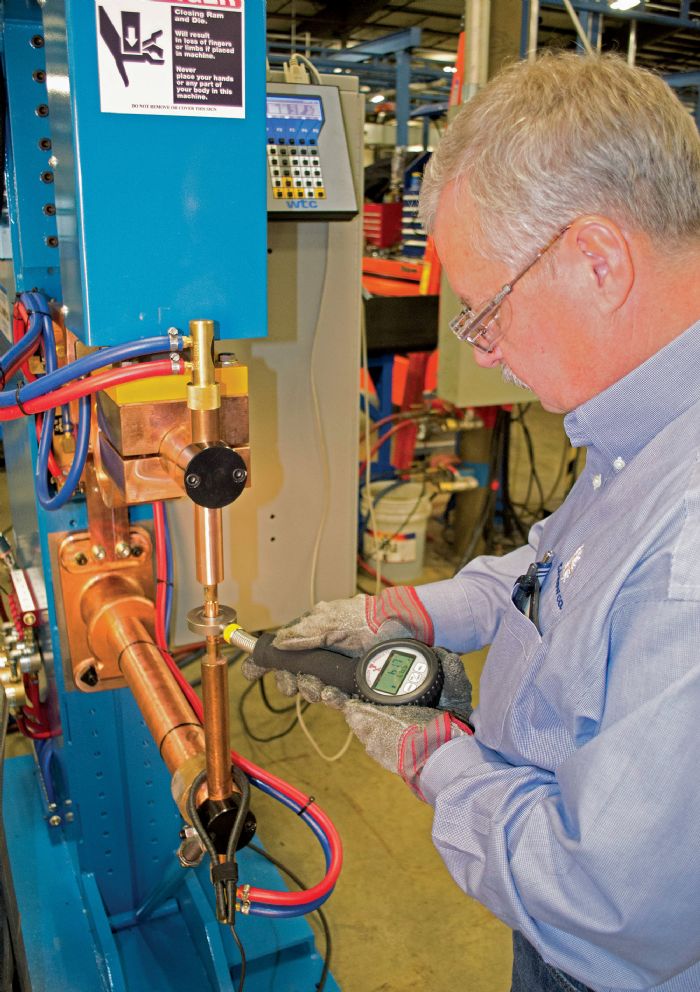 As previously noted, set weld time as short as possible. Subsequently, hold time—in sequence immediately after weld time—allows the weld to cool for a short period with the weld force still applied. Then, off time only is used if the welding machine is set to automatically repeat, similar to a sewing machine.
As previously noted, set weld time as short as possible. Subsequently, hold time—in sequence immediately after weld time—allows the weld to cool for a short period with the weld force still applied. Then, off time only is used if the welding machine is set to automatically repeat, similar to a sewing machine.
Cooling Water
As most RW machines are water-cooled, do not overlook water flow rate and temperature as key process variables. RW machines are thirsty and adequate water flow typically is more important than water temperature. For example, a high flow rate of 80-deg. water will prove more effective than 45-deg. water at a low flow rate.
As the cost of using city water to cool an RW machine can be high and the incoming temperature often too cold, the simplest solution is to employ a closed-loop recirculating system. Beware: Some of these systems operate better than others. And, as with all things related to RW machines, consistency holds the key to success.
Common machine water-cooling gotchas:
- Cooling towers are not ideal for suppling RW machines, because changing ambient-air temperatures cause inconsistent cooling-water temperature.
- We also do not recommend the small radiator-type recirculators commonly used with arc-welding machines, due to low flow rates and changing temperatures.
- Plant-wide water systems often provide inconsistent flow rates due to varying head pressure.
- When water systems use black-iron plumbing instead of PVC, rust will eventually clog the welding machine’s small-diameter internal water-cooling lines.
- City and well water contain minerals that will clog water-cooling circuits over time.
- The best choice: a properly sized self-contained water recirculator/ chiller. However, with these be sure to set the chiller’s water temperature above the prevailing dew point or condensation will form. This can cause the welding machine’s transformer or weld control to become saturated and eventually short out.
$50,000 Gotcha
RW expert Don DeCorte, of RoMan Manufacturing, a global supplier of RW transformers, shares this example of an expensive gotcha:
“One of my customers, a large automotive plant, was experiencing high electrode-cap failure rates on several robotic spot-welding guns. I was asked to review the situation because the plant’s welding engineers were blaming the electrode-cap supplier for premature failures.
“I spent an hour listening to them and walking around the plant so that they could show me the various welding guns that had experienced the issue. In a few cases, they had identical welding guns on the left and right side of the production line and the gun on one side had good electrode life while the gun on the other side experienced poor electrode life.
“I asked them to remove the caps on each of the two guns and we found that, on the gun with poor electrode life, the small brass water tube feeding water from inside the gun arm into the electrode cap adaptor had broken off. We then took apart 16 more guns experiencing electrode-life issues and found that the tubes were missing on all of them. Without the short 1.5-in. brass tube installed, cooling water was not getting out to the end of the cap adaptor and into the caps. Some water did squirt across the gap and found its way into the cap, but not much.
“After they replaced all of the missing brass water tubes, a week later the plant manager told me it was a ‘miracle’—electrode-cap life was good on all of the guns. He estimated that they had been running with missing tubes for 5 months, while the welding engineers and maintenance guys argued about electrode-cap alloys, cap dimensions and cap dressers. Instead, the problem was a $2 part that they replaced in 10 min.
“The plant’s maintenance manager said that the simple issue of missing water tubes had likely cost them $50,000 in additional electrode-cap usage and lost production.”
A Dopey Gotcha
Another common gotcha related to water cooling results from well-meaning maintenance personnel who use pipe dope or plumber’s tape to solve the common problem of water leaking from the threaded copper electrode adaptor or tapered electrode-holder socket.
Because the secondary output voltage of an RW machine is very low—typically only 6-10 V—the dope or tape used to stop a water leak also serves as an electrical insulator and prevents welding current from flowing through the joint. This problem can prove especially hard to identify if the maintenance person carefully trims the white plumber’s tape so it doesn’t show.
CRWT Training
Want to learn more about the RW process and hopefully prevent these and other costly gotchas? Check out the training courses offered by the Resistance Welding Manufacturing Alliance, a standing committee of the American Welding Society (AWS), and other venders. Once trained, consider taking the 100-question AWS exam, leading to recognition as a Certified Resistance Welding Technician (CRWT). MF
In addition to Don DeCorte of RoMan Manufacturing, Matt Post of T. J. Snow Co. also contributed to this article.
View Glossary of Metalforming Terms
See also: T. J. Snow Company
Technologies: Welding and Joining







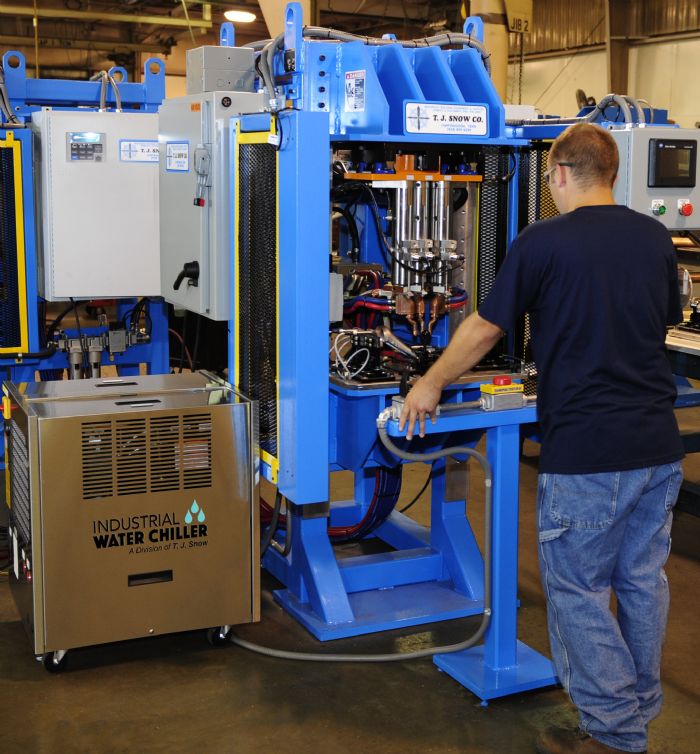 Since the RW process is robust, reliable and generally forgiving, metal formers may tend to ignore the process—until quality problems occur. Then, expensive product recalls can result in an ill-advised, kneejerk desire to switch to assembly alternatives such as expensive screws, rivets, adhesives or mechanical clinching.
Since the RW process is robust, reliable and generally forgiving, metal formers may tend to ignore the process—until quality problems occur. Then, expensive product recalls can result in an ill-advised, kneejerk desire to switch to assembly alternatives such as expensive screws, rivets, adhesives or mechanical clinching.